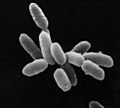Haloarchaea (halophilic archaea, halophilic archaebacteria, halobacteria) are a class of prokaryotic organisms under the archaeal phylum Euryarchaeota...
29 KB (2,962 words) - 08:29, 31 May 2024
exist today are photosynthetic microbes collectively called Haloarchaea. Many Haloarchaea contain the retinal derivative protein bacteriorhodopsin in...
10 KB (1,090 words) - 11:47, 11 September 2024
Alphasphaerolipovirus is a genus of double stranded DNA viruses that infect haloarchaea. The genus contains four species. The genus contains the following species:...
2 KB (140 words) - 07:04, 2 January 2024
Bacteriorhodopsin (Bop) is a protein used by Archaea, most notably by haloarchaea, a class of the Euryarchaeota. It acts as a proton pump; that is, it...
21 KB (2,123 words) - 02:13, 27 August 2024
ammonia, metal ions or even hydrogen gas. Salt-tolerant archaea (the Haloarchaea) use sunlight as an energy source, and other species of archaea fix carbon...
133 KB (13,817 words) - 07:02, 19 September 2024
2010. Retrieved 20 July 2009. Dyall-Smith, Mike, HALOARCHAEA, University of Melbourne. See also Haloarchaea. Olsson, Karen; Keis, Stefanie; Morgan, Hugh W...
74 KB (7,754 words) - 01:47, 13 September 2024
that produce oxygen as a byproduct, while a small minority (such as haloarchaea and sulfur-reducing bacteria) perform anoxygenic photosynthesis. Chemical...
7 KB (690 words) - 06:24, 16 August 2024
optimum growth occurring Euryarchaeota – In the taxonomy of microorganisms Haloarchaea Halobacteriales – in taxonomy, the Halobacteriales are an order of the...
11 KB (767 words) - 16:50, 20 July 2024
contain high concentrations of halophilic microorganisms, primarily haloarchaea but also other halophiles including algae and bacteria. Salterns usually...
5 KB (476 words) - 22:50, 28 March 2024
hypersaline lake: genomic assessment of ecophysiology among dominant haloarchaea". The ISME Journal. 8 (8). Springer Science and Business Media LLC: 1645–1658...
15 KB (975 words) - 00:31, 18 September 2024
hypersaline lake: genomic assessment of ecophysiology among dominant haloarchaea". The ISME Journal. 8 (8). Springer Science and Business Media LLC: 1645–1658...
5 KB (349 words) - 06:27, 12 February 2024
DasSarma, Shiladitya (2012-01-01). "The core and unique proteins of haloarchaea". BMC Genomics. 13: 39. doi:10.1186/1471-2164-13-39. ISSN 1471-2164....
14 KB (1,429 words) - 15:59, 17 December 2023
just osmoprotectants. Of particular note are the extreme halophiles or haloarchaea (often known as halobacteria), a group of archaea, which require at least...
22 KB (2,705 words) - 23:57, 27 May 2024
had turned pink due to a large presence of the salt-loving "haloarchaea" microbes. Haloarchaea or halophilic archaea is a bacteria culture that produces...
63 KB (681 words) - 23:54, 4 September 2024
Bacteriorhodopsin is a light-driven proton pump used by Archaea, most notably in Haloarchaea. Light is absorbed by a retinal pigment covalently linked to the protein...
13 KB (1,530 words) - 01:29, 14 January 2024
sugars, to ammonia, metal ions or even hydrogen gas. The salt-tolerant Haloarchaea use sunlight as an energy source, and other species of archaea fix carbon...
156 KB (16,498 words) - 04:39, 18 September 2024
use a mix of SD sequence, Kozak sequence, and leaderless initiation. Haloarchaea are known to have a variant of the Kozak consensus sequence in their...
30 KB (3,629 words) - 08:55, 7 July 2024
exception of Heimdallarchaeota, photosynthesis is not found in archaea. Haloarchaea are phototrophic and can absorb energy from the sun, but do not harvest...
109 KB (11,779 words) - 23:18, 7 September 2024
orange hue. Halobacteria, a type of halophilic Archaea (also known as Haloarchaea), are responsible for changing the color of middle to high-salinity ponds...
11 KB (1,108 words) - 04:44, 12 September 2024
activity, aw ≤ 0.78 to 0.86—a level fatal to most Terrestrial life. Haloarchaea, however, are able to live in hypersaline solutions, up to the saturation...
206 KB (19,996 words) - 15:22, 7 September 2024
membrane-associated proteases: insights on Haloferax volcanii and other haloarchaea". Frontiers in Microbiology. 6: 39. doi:10.3389/fmicb.2015.00039. PMC 4343526...
26 KB (2,799 words) - 15:02, 30 June 2024
species of algae which releases beta-carotene, and the bacteria-like haloarchaea, which together give the water an unusual reddish or purplish color....
79 KB (8,609 words) - 04:59, 21 September 2024
hypersaline habitats, which they share with the extremely halophilic haloarchaea. Nanohaloarchaea were first identified from metagenomic data as a class...
12 KB (1,176 words) - 19:02, 2 March 2024
by the abnormally low Guanine-Cytosine (GC) content compared to other haloarchaea. H. walsbyi has an average of 47.9% GC content compared to the expected...
22 KB (2,535 words) - 12:05, 12 June 2024
Yingchengvirus is a genus of double stranded DNA viruses that infect haloarchaea. The genus was previously named Betasphaerolipovirus. The genus contains...
4 KB (379 words) - 12:34, 30 January 2023
Nam, Y. D.; Roh, S. W. (2015). "Occurrence of viable, red-pigmented haloarchaea in the plumage of captive flamingoes". Scientific Reports. 5: 16425....
44 KB (5,282 words) - 00:53, 12 September 2024
antibiotics friulimicin and vicenistatin and in carbon metabolism of haloarchaea (Methylaspartate cycle). Ogasawara, Y.; Kakinuma, K.; Eguchi, T. (2005)...
2 KB (119 words) - 12:50, 18 September 2023
similar structure. CetZ functions in cell shape changes in pleomorphic Haloarchaea. In Haloferax volcanii, CetZ forms dynamic cytoskeletal structures required...
32 KB (3,393 words) - 05:32, 15 June 2024





















